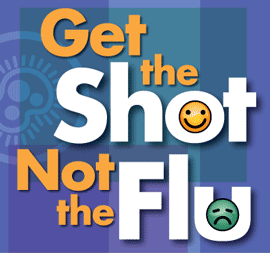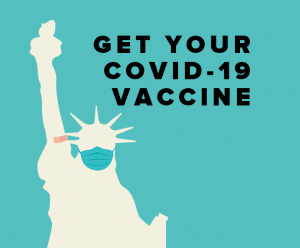As a skeptic or contrarian—someone who doesn’t blindly accept the pronouncements of public health officials as the gospel truth—I’ve long questioned the validity of the statement that flu vaccines were “effective.”
 Advertisement for Putnum County, NY, Three Fall Public Flu Clinics
Advertisement for Putnum County, NY, Three Fall Public Flu Clinics
From the data in an article published at The Daily Expose, I learned that approximately 50 percent of Americans received a flu vaccine in the five flu seasons through 2019-2020. In the 2019-2020 flu season, 174.5 million doses of flu vaccine were administered to Americans. This means 53 percent of the U.S. population (of 329.5 million in 2020) were vaccinated against the flu that year.
The data contained in this analysis supports my skepticism. For example, according to CDC estimates, in the flu season of 2017-2018, 45 million Americans became ill with influenza. This means 13.8 percent of the U.S. population came down with the flu in the roughly five months of the 2017-2018 flu season. This “severe” and “widespread” flu outbreak occurred despite almost 48 percent of the U.S. population being vaccinated against the flu that year.
As with the COVID vaccines, public health officials occasionally acknowledge that vaccination may not prevent infection but stress that these jabs will reduce the severity of your case if you still contract the virus. However, the numbers from the 2017-2018 flu season make a skeptic question this assertion. For example, the CDC now estimates that 51,646 Americans died from the flu in the 2017-2018 flu season (which was the most severe in recent years.)
Even this mortality number is questionable as for more than a year, the CDC’s death estimate was 80,000. For reasons unclear to this correspondent, this death estimate was later changed to 61,000 and, as noted, has now been revised down again to 51,646. These revisions, which reduced the “official” number of “flu deaths” by almost 30,000, make one wonder if, at some point in the future, the number of COVID deaths might also be reduced dramatically via little-seen press releases or website adjustments.
 One should also note that flu vaccination rates are much higher among the elderly, where vaccination rates approach or exceed 70 percent. The much-higher vaccination rates among senior citizens are significant as the overwhelming majority of “deaths from the flu” occur among the elderly. According to CDC statistics cited above, in the 2017-2018 flu season, 83.3 percent of flu deaths occurred among those age 65 or older, by far the most heavily vaccinated group.
One should also note that flu vaccination rates are much higher among the elderly, where vaccination rates approach or exceed 70 percent. The much-higher vaccination rates among senior citizens are significant as the overwhelming majority of “deaths from the flu” occur among the elderly. According to CDC statistics cited above, in the 2017-2018 flu season, 83.3 percent of flu deaths occurred among those age 65 or older, by far the most heavily vaccinated group.
While rarely publicized, it seems evident that in many flu seasons, the viruses used to create that year’s flu vaccines do NOT match the viruses that eventually materialize and spread. Speaking for myself, I would be very interested in reading any journalism that goes back in time and shows the flu seasons where the flu vaccines did match that year’s dominant flu strains. Do the manufacturers of the flu vaccines “guess” right in 70 percent of flu seasons? Fifty percent? Thirty percent? The public doesn’t know, the reporters don’t ask, and the public health officials don’t tell.
Vaccine producers certainly guessed wrong in 2017-2018… or if they guessed correct—and 14 percent of Americans still came down with the flu—what does this say about the “effectiveness” of the flu vaccine? If you search, you can find some stories that say a given year’s flu vaccine did NOT match that year’s dominant strain of flu. To me, these quotes are an admission that—at least in this particular year—the flu vaccine did not “work.”
 It’s a Good Time to Get Your Flu Vaccine.
It’s a Good Time to Get Your Flu Vaccine.
Ad from the Food and Drug Administration.
When reading such articles, I’m always left scratching my head when I come upon the obligatory quote or sentence, typically included somewhere at the bottom of the story: But health officials or doctors say, “It’s not too late to get a flu shot this season.” Re-stated (as I would write these articles): “This year’s flu vaccine does not work, but public health officials strongly recommend everyone get their flu shot anyway.” While I have highlighted the widespread and severe flu season of 2017-2018, this is not the only season where the flu vaccine was not a “match” for the predominant flu strains. For example, I can report that the one season I did get a flu vaccine (about a decade ago), I came down with the flu. True, this would qualify as “anecdotal evidence,” but it is an “anecdote” that tens of millions of other Americans could probably report. And I did not suffer a “mild” case of the flu that year. I was sick as a dog for about a week. In fact, unlike COVID, I have never heard of one person who suffered an “asymptomatic” case of the flu.
At least in many years, flu vaccines may meet experts’ definitions of “safe,” but they certainly don’t meet this layman’s definition of “effective.” (In doing research for this piece, I did find one article that quantified the “effectiveness” of the 2017-2018 flu vaccine in Canada—“10 percent.”) Once upon a time, most Americans probably thought that a “vaccine” prevented disease and its spread. After decades of non-stop marketing (some might say propaganda) about the necessity of being vaccinated against the flu, the definition of (or people’s thinking about) what a vaccine actually does clearly changed. If more people recognized that, more often than not, flu “vaccines” are “ineffective,” perhaps fewer people would have been convinced that the COVID vaccines would be, say, “95 percent effective.”
The fact that the narrative about the “effectiveness” of the flu vaccines has never been challenged by skeptical “watchdog” journalists almost certainly helped pave the way for the successful rollout of the COVID “vaccines.” Even today, the CDC recommendation that “even during seasons when there is a less than ideal match … “everyone six months and older” should be vaccinated against the flu is widely viewed as sacrosanct.
 In my view, Robert Kennedy, Jr. is absolutely correct when he suggests that public health agencies have essentially become vaccine promotion agencies. As we also know that few if any reporters from the establishment press are going to question the pronouncement of any “public health official,” an all-important (and arguably new) narrative about vaccines was both created and then protected.
In my view, Robert Kennedy, Jr. is absolutely correct when he suggests that public health agencies have essentially become vaccine promotion agencies. As we also know that few if any reporters from the establishment press are going to question the pronouncement of any “public health official,” an all-important (and arguably new) narrative about vaccines was both created and then protected.
And, for the record, I am not an “anti-vaxxer.” I would not have let my children get their polio and diphtheria vaccines if I were. I allowed this for one reason: I think these vaccines actually prevent polio and Diptheria.
 Advertisement from Jana Healthcare "It is very important to get your COVID-19 vaccine as soon as possible!"
Advertisement from Jana Healthcare "It is very important to get your COVID-19 vaccine as soon as possible!"
Nor does it bother me if most Americans choose to get a flu vaccine. As long as my government doesn’t make such inoculations compulsory, I say, “It’s your body, your choice.” In a free country, adults can certainly perform their own risk-benefit health calculations and gauge for themselves the credibility of claims made by Big Pharma and public health bureaucrats. However, when doctors gently (or not so gently) pressure my children or me to get vaccinated against the flu… or against COVID, I politely decline.
So far, few have asked me why I declined their invitation/recommendation, but I might refer them to this article if they did.


